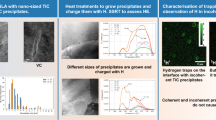Abstract
Quenched and tempered 5.5Ni steel was embrittled by hydrogen charging and broken in air at room temperature. The primary fracture mode was transgranular quasicleavage. The quasicleavage facets were studied by scanning electron fractography and by transmission electron microscopy of profile fractographic specimens. The latter were prepared by plating the fracture surface with nickel and thinning so that the fracture surface was contained within the region of the specimen that was transparent to the electron beam. The fracture surface generally followed martensite lath boundaries. In addition, interlath microcracks were frequently found in the material immediately beneath the fracture surface. These results suggest that transgranular hydrogen embrittlement in this steel is primarily an interlath cracking phenomenon. Since the lath boundary planes tend to lie in {110}, the results also explain the prevalence of {110} quasicleavage in the embrittled specimens, which contrasts with the {100} cleavage found in uncharged specimens broken below the ductile-to-brittle transition temperature.
Similar content being viewed by others
References
Kikuta. T. Araki, and T. Kuroda:Fractography in Failure Analysis, B.M. Strauss and W.M. Cullen, Jr., eds., ASTM STP 645, American Society for Testing and Materials, 1978, p. 107.
Y. Kikuta and T. Araki:Hydrogen Effects in Metals, I. M. Bernstein and A.W. Thompson, eds., TMS-AIME, Warrendale, PA, 1981, p. 309.
F. Nakasoto and I. M. Bernstein:Metall. Trans. A, 1978, vol. 9A, p. 1317.
I.M. Bernstein:Metall. Trans. A, 1970, vol. 1, p. 3143.
Y. Takeda and C.J. McMahon, Jr.:Metall. Trans. A, 1981, vol. 12A, p. 1255.
C. J. McMahon, Jr.:Hydrogen Effects in Metals, I. M. Bernstein and A.W. Thompson, eds., TMS-AIME, Warrendale, PA, 1981, p. 219.
J. I. Kim: Ph.D. Thesis, Department of Materials Science and Mineral Engineering, University of California, Berkeley, CA, 1979.
J. I. Kim, C. K. Syn, and J. W. Morris, Jr.:Metall. Trans. A, 1983, vol. 14A, p. 93.
M. Nagumo, H. Morikawa, and K. Miyamoto: Proceedings JIMIS-2, Hydrogen in Metals, Suppl. Trans. Japan Inst. Metals, 1980, vol. 21, p. 405.
H. Haga and H. Mimura:Trans. Japan Inst. Metals, 1972, vol. 13, p. 155.
C. K. Syn, B. Fultz, and J. W. Morris, Jr.:Metall. Trans. A, 1978, vol. 9A, p. 1635.
S. Matsuda, T. Inoue, H. Mimura, and Y. Okamura:Toward Improved Ductility and Toughness, Climax Molybdenum Development Co. (Japan) Ltd., Kyoto, 1972, p. 45.
S. Hogmark, H. Swahn, and O. Vingsbo:Ultramicroscopy, 1975, vol. 1, p. 113.
J. Tien, S. Nair, and R. Jensen:Hydrogen Effects in Metals, I.M. Bernstein and A. W. Thompson, eds., TMS-AIME, Warrendale, PA, 1981, p. 37.
Y. Kikuta,ibid.,, p. 755.
Author information
Authors and Affiliations
Rights and permissions
About this article
Cite this article
Kim, Y.H., Morris, J.W. The nature of quasicleavage fracture in tempered 5.5Ni steel after hydrogen charging. Metall Trans A 14, 1883–1888 (1983). https://doi.org/10.1007/BF02645559
Received:
Issue Date:
DOI: https://doi.org/10.1007/BF02645559




